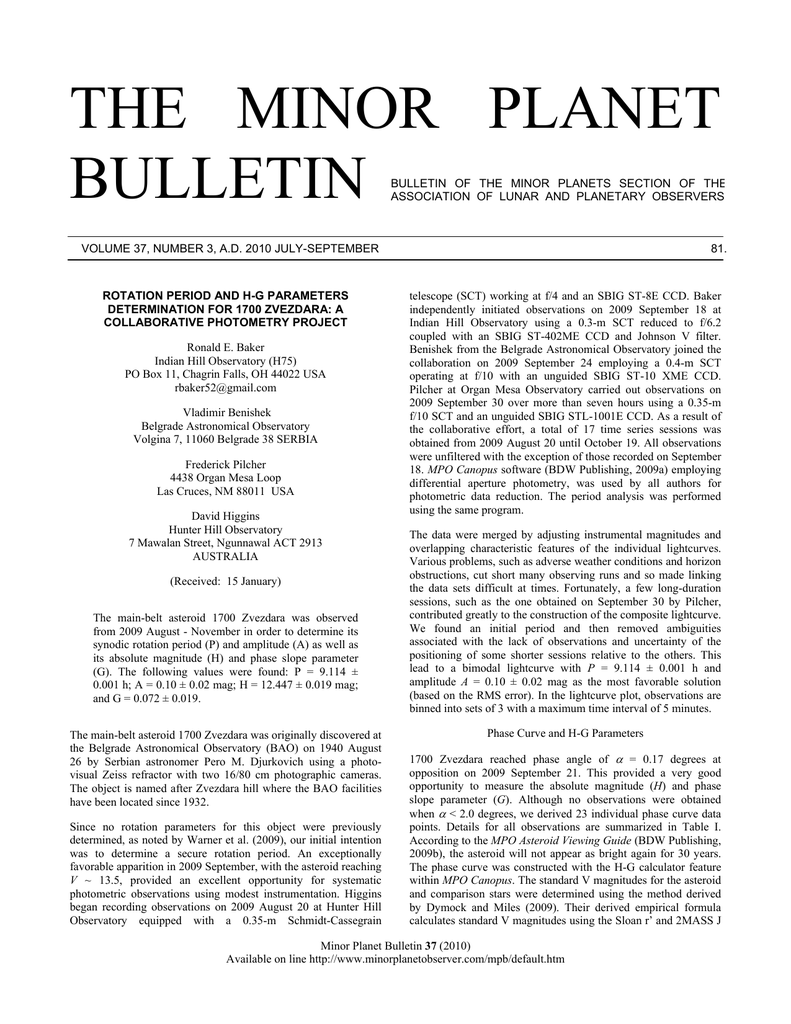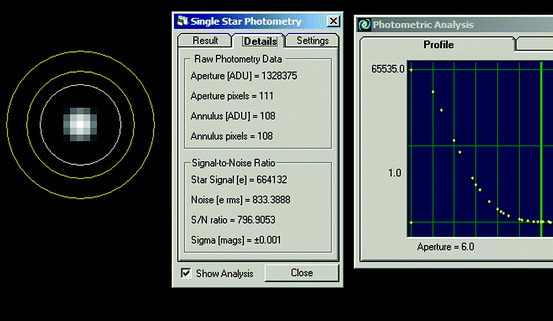Software Development for Asteroid and Variable Star Research
- Canopus Photometry Software Download
- Canopus Photometry Software Review
- Canopus Photometry Software Windows 10
- Canopus Photometry Software Free
Abstract
The process of collecting and analyzing light curves from variable stars and asteroids is almost identical. In 2016 a collaboration was created to develop a simple fundamental way to study both asteroids and variable stars using methods that would allow the process to be repeated by middle school and high school students.Using robotic telescopes at Cerro Tololo (Chile), Yerkes Observatory (US), and Stone Edge Observatory (US) data were collected on RV Del and three asteroids. It was discovered that the only available software program which could be easily installed on lab computers was MPO Canopus. However, after six months it was determined that MPO Canopus was not an acceptable option because of the steep learning curve, lack of documentation and technical support.Therefore, the project decided that the best option was to design our own python based software. Using python and python libraries we developed code that can be used for photometry and can be easily changed to the user's needs. We accomplished this by meeting with our mentor astronomer, Tyler Linder, and in the beginning wrote two different programs, one for asteroids and one for variable stars. In the end, though, we chose to combine codes so that the program would be capable of performing photometry for both moving and static objects.The software performs differential photometry by comparing the magnitude of known reference stars to the object being studied. For asteroids, the image timestamps are used to obtain ephemeris of the asteroid from JPL Horizons automatically.
Software tools for Supernova Searching. There’s a plorithera of astronomy software out there for everything from the ktichen sink to photometry. I have found it hard to wade through this thick soup of software titles when trying to identify what is needed for research goals such as supernova searching. Bined into one file and by using the MOP Canopus software we have determined the value of the rotation period to be P = 2.352 ±0.210 hours. Keywords:minor planets – near Earth objects – 3122 Florence – photometry – periods Introduction In the scope of our astrometric program, we have decided to observe the.
Announcement
Minor Planet Observer's Canopus Software
Special Edition now included for free withphotometric filter sets
and available for free to all new camera purchasers as of
June 1, 2006
SBIG is proud to include a free version of BrianWarner's MPO Canopus software with every new Photometric filter set, and a coupon for afree copy of the software with every new camera beginning June 1, 2006.
MPO Canopus is one of the leading astrometry andphotometry programs available for amateur use. With just one program you can processand measure your images, do photometric transforms, generate lightcurves, analyze periodsand times of minimum, look for new asteroids or new variables, and much more. Special features built into Canopus make measuring images and analyzing lightcurvecharacteristics simple and easy. In just a few minutes, you can setup, measure150-200 images, and start analyzing the lightcurve data. You can easily combine data fromseveral nights and even different observers. MPO Canopus has been around since 1999,and has been used by amateurs around the world to submit thousands of astrometricpositions to the Minor Planet Center.
Also since 1999, MPO Canopus has been used tomeasure images to determine the rotation period of hundreds of asteroids with many of theresults appearing in journals such as the Minor Planet Bulletin and Icarus. In recentyears, Canopus has also gained popularity for measuring and determining the lightcurves ofvariable stars. Canopus can even generate special files compatible with 'BinaryMaker', a popular binary star modeling program.
Canopus uses the 'industry standard'Fourier analysis algorithm developed by Alan W. Harris for period analysis. While designedspecifically for asteroid work, the routine in Canopus works very well on eclipsingbinaries and other types of variables that have single periodic curves. Canopus has employed 'ensemble photometry' from the beginning, allowing up tofive comparison stars to be used to generate an average value subtracted from themeasurement of the target object, be it an asteroid or variable star.
PhotoRed (PHOTOmetric REDuctions) is a utilityprogram built into Canopus that allows you to covert the raw instrumental magnitudesmeasured in Canopus or PhotoRed to the Johnson-Cousins standard magnitude system. There'sno need to use a spread sheet or other program in order to make the final calculations. PhotoRed determines the nightly extinction, transforms, and zero points using yourimages of standard fields. Once you have those values, you import the Canopus data intoPhotoRed, convert the magnitudes to standard values, and export the data back for Canopusto use. PhotoRed includes provisions to convert Clear (unfiltered) observations tostandard V, assuming you have at least some images in V of the target and a referencefield. Higher accuracy can be achieved by having additional images in B or R.
Furthermore, both Canopus and PhotoRed produceplots of critical data so that you can easily eliminate obvious outliers or analyze theresults with more certainty. What makes Canopus/PhotoRed stand out is that they areself-contained. You don't need to export your data to other programs to do calculations ordo data analysis.
GENERAL FEATURES:
- Includes MPO Star Catalog (MPOSC), a 15M star subset of the USNO A2. 36M star version of MPOSC is included on registered DVD version.
- Supports full USNO A catalog (available separately) and UCAC2 (3-CD set from USNO). Full UCAC2 is included on registered DVD version.
- Includes recent versions of the MPCORB and ASTORB asteroid files as well as a subset of the Henden fields (approximately 400 fields with stars having Verror <0.02m and min of 3 observations).
- Complete electronic documentation (PDF) that includes a Users Guide: a set of step-by-step tutorial lessons that guide the user from initial setup, to lightcurve period analysis, to photometry reductions using example images included on the CD.
- Free technical support via a Yahoo news group. Registered users get (usually) free updates via the MPO web site.
PHOTOMETRY FEATURES (Canopus)

- Ensemble aperture photometry using up to five (5) comparison stars.
- Records instrumental magnitude of each star and target as well as date/time and air mass.
- Data can be saved to simple text files for custom analysis in other programs or to special export files for easy data exchange among other Canopus users.
- Period analysis using Alan Harris' 'industry standard' Fourier analysis algorithm.
- Works on asteroids or variable stars with single period.
- Easy setup using a 'Lightcurve Wizard' that allows measuring hundreds of images per hour.
- Manual override of measurements allows full control of the measuring process.
PHOTOMETRY FEATURES (PhotoRed)
- Uses several wizards for easy setup to measure images
- Use to find first order extinction, transformation coefficients, and convert raw instrumental magnitudes onto Johnson-Cousins BVRI system.
- Includes special routines to convert Clear to V magnitudes that account for color dependencies of the system.
- Can import data directly from Canopus data files. After conversion, the data can be saved out in the Canopus export files for use in Canopus for period analysis and detailed plotting.
- Plots of all critical analysis results are included in order to maintain full control over the reduction process, e.g., spotting outlier points or otherwise 'bad data.'
DEMO VERSION FEATURES
Some of the features in the registered version of MPO Canopus/PhotoRed are disabled in this special edition. However, all the features you'll need to measure images, find the period of a lightcurve, and reduce your data to standard magnitudes are fully available.
Canopus Photometry Software Download
Only some of the 'bonus' utilities that make Canopus/PhotoRed even more powerful research tools have been disabled. These include the Moving Object Search, Variable Star Search, and Double Star Measurements utilities along with some utilities that allow you to make backups of certain files.
Canopus Photometry Software Review
Canopus uses the concept of 'sessions' to work with data from different nights, filters, observers, etc. You are limited to 100 sessions in this special edition of the software. That should be more than enough to get you going. When you purchase a registered copy, your data will be preserved and so you can continue on without missing a step.

The Conversion utilities are also disabled. These allow you to update the MPCORB and ASTORB asteroid data files as well as the UserStar catalog where you can add custom stars used for photometry reductions. This is NOT a time-limited version of the software. You can use it indefinitely. However, you will not be able to get the free updates that are available to registered users.
UPGRADE
Upgrade to the full version of MPO Canopus/PhotoRed by contacting MPO at: http://www.minorplanetobserver.com
Also recommended reading is Brian Warner's book: 'A Practical Guide to Lightcurve Photometry and Analysis'
available at Amazon.com and BarnesNoble.com
SYSTEM REQUIREMENTS
Canopus Photometry Software Windows 10
MPO Canopus/PhotoRed Requirements:
PC Operating System: Windows 95 and above
Screen: 800x600x256 minimum, 1024x768x64K recommended (or higher)
Memory: That required to run O/S efficiently
Free Disk Space: About 1GB
Revised: June 02, 2006 02:08:10 PM.
Copyright © 2006 Santa Barbara Instrument Group, Inc. All rights reserved.
Please report any problems with this page directly to the Webmaster